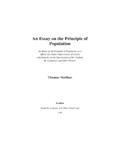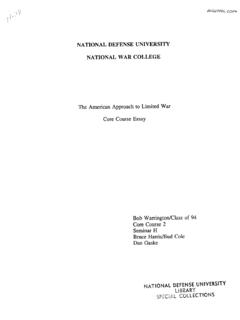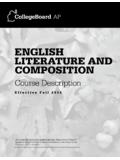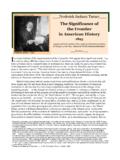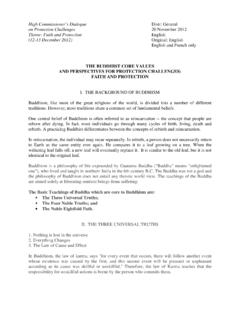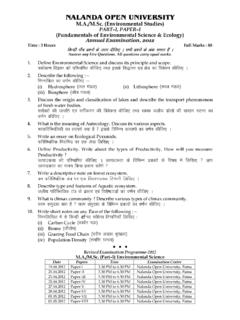Transcription of Female power: witchcraft and gender in …
1 1 of 29 Kate Dumycz 2005 Cert Hum(Open), Adv Dip Local History (Oxford) Female power : witchcraft and gender in elizabethan England. Ioane Cunny, liuing very lewdly, hauing two lewde Daughters, no better then naughty packs, had two Bastard Children: beeing both boyes, these two Children were cheefe witnesses, and gaue in great euidence against their Grandam and Mothers, the eldest being about 10. or 12. yeeres of age. Against this Mother Cunny the elder Boye gaue in this euideoce which she herselfe after confessed, that she going to Braintye Market, came to one Harry Finches house, to demaund some drink, his wife being busie and a brewing, tolde her she had no leysure to giue her any. Then Ioane Cunnye went away discontented: and at night Finches wife was greeuously taken in her head, and the next day in her side, and so continued in most horrible paine for the space of a week, and then dyed. 1 In 1589 Joan Cunny and her two daughters, Avice and Margaret, all from Stisted, Essex, were brought before the Summer Assizes in Chelmsford charged with witchcraft .
2 Undoubtedly the two daughters, by having illegitimate children, lived outside the norms of elizabethan society: a society where it has been estimated that only one to four percent of the population were illegitimate2. Joan and Avice were charged with causing people to die by witchcraft a crime punishable by the death penalty and Margaret was accused of the lesser offences of two counts of bewitchment. All three women were found guilty: Joan and Avice were sentenced to hang and Margaret sentenced to one year (and six appearances in the stocks). Joan was hanged immediately after her trial but Avice had pleaded pregnancy and, as she was found to be pregnant by a jury of matrons (which included Joan Robinson who had been implicated in the St 1 Anon; (1589) The apprehension and confession of three notorious witches. Arreigned and by iustice condemned and executed at Chelmes-forde, in the Countye of Essex 2 Munro, J; (2004) The economic history of later-Medieval and Early-Modern Europe p28 1589 Joan Cunny, Joan Upney and Joan Prentice1 2 of 29 Kate Dumycz 2005 Cert Hum(Open), Adv Dip Local History (Oxford) Oysth witch-trials of 15823), she was hung the following year after the birth of her Joan s crime, along with two other convicted Essex witches, was duly retold in a contemporary pamphlet The arraignment and execution of three detestable witches 1.
3 The Cunny family of witches was just one small example of the witchcraft trials that took place within England at the regular county Assizes between the first elizabethan witchcraft statute of 1563 (an Act against Conjuracions Inchantments and Witchecraftes5 ) and the harsher 1604 Jacobean witchcraft act (an Act against Conjuration Witchcrafte and dealinge with evil and wicked Spirits6 ) which was finally repealed in 1736. Today, these witchcraft cases are much studied by historians and anthropologists both through official records such as the Assizes and Quarter Sessions accounts and unofficial accounts, such as contemporary treatises and pamphlets, in the quest to provide a picture of life and relationships within sixteenth and seventeenth century communities of England. Contemporary people throughout England and Europe were fascinated by witches and the perception of malicious harm caused to both people and animals by people practising witchcraft .
4 It seems that all levels of society believed in witches from King James I of England (who, as James VI of Scotland, wrote Daemonologie (1597), an influential treatise on the subject) to the victims and witnesses who reported their former friends and neighbours as witches to the authorities. In addition to the contemporary pamphlets that appeared after notorious and high profile cases such as the 1566 pamphlet describing the Hatfield Peverel witches, there were also tracts written by influential writers and contemporary clergymen. Some, such as Reginald Scot were highly sceptical about witchcraft : in 1584 he wrote The Discovery of witchcraft putting over his opinion that If it were true that 3 Harris, A; (2001), Witch-hunt: the great Essex witch scare of 1582; p63 4 Rosen, B; (1991) witchcraft in England 1558-1618; p182 5 MacFarlane, A; (1970) witchcraft in Tudor and Stuart England: A regional and comparative study; p14 6 Ewen, C L Estrange; (1929) Witch Hunting and Witch Trials : The Indictments for witchcraft from the Records of 1373 Assizes held for the Home Circuit 1559-1736; p19 3 of 29 Kate Dumycz 2005 Cert Hum(Open), Adv Dip Local History (Oxford) witches confesse, or that all writers write or that witchmongers report, or that fooles believe, we should never have butter in the chearne, nor cow in the close, nor corne in the field, nor faire weather abroad, nor helth within doores.
5 7 Others, such as George Gifford, the vicar of Malden, writing in 1593 confirmed the view that witchcraft existed: there be two or three [witches] in our town which I like not, but especially an old woman. I have bene as careful to please her as ever I was to please mine own mother, and to give her ever and anon one thing or other, and yet methinks she frownes at me now and then8. In recent times, witchcraft in early modern England has been much studied by many eminent historians and anthropologists such as Alan MacFarlane9, Keith Thomas10, Robin Briggs11 and James Sharpe12. An explanation for witchcraft that modern historians such as Thomas and MacFarlane have put forward is that the accusations occurred when there were disputes between people. Thomas observed: [this was a] tightly-knit, intolerant world with which the witch had parted company. She was the extreme example of the malignant or non-conforming person against whom the local community had always taken punitive action in the interests of social harmony.
6 13 He further remarks that when there was a breakdown of the mutual help 7 Scot, R; (1584) as quoted in Haining, P; (1974), The witch-craft papers: contemporary records of the witchcraft Hysteria in Essex 1560-1700; p68 8 Gifford, G; (1593), as quoted in Haining, P; The witch-craft papers; p78 9 witchcraft in Tudor and Stuart England 10 Religion and the decline of Magic 11 Witches and neighbours 12 1) witchcraft in early Modern England; 2) The bewitching of Anne Gunter: A horrible and true story of football, witchcraft , murder and the King of England, 3) English witchcraft 1560-1736; Volumes 1 to 6 (Gen Ed) 13 Thomas, K; (1991), Religion and the Decline of Magic; p632 A bewitched ship as portrayed in Reginald Scot s 1584 The Discovery of witchcraft 4 of 29 Kate Dumycz 2005 Cert Hum(Open), Adv Dip Local History (Oxford) that many English villagers relied on during this period, accusations of witchcraft often In addition to these socio-economic based questions, questions about gender relations within these tight-knit communities have been asked.
7 These gender questions have ranged from the Marxist and feminist view that the witchcraft trials were a ruling class campaign of terror against the Female peasant population15 to the view that witchcraft was something which operated with the Female social and cultural spheres, or, at least, as a specifically Female form of power 16. As Marion Gibson observes The stories in the pamphlets make it hard to escape the conclusion that witch prosecution was often an expression of fears of supposed Female power as well as a distaste for the uneducated, impious and criminal worser sort and an expression of frustration from the young to the old 17. From the records of the witchcraft trials, can a modern day historian ask gender questions of the data such the attitudes towards women both from other females and males? Perhaps more specifically, can enquiries be made such as, if there were problems within the village and within that community was a Female who lived outside the norm of contemporary society (for example, having illegitimate children or were fornicating with men outside of marriage), were they the type of person more likely to be accused of performing acts of witchcraft ?
8 Or, was an act of witchcraft one of the few ways that a contemporary Female asserted her power over 14 Ibid; p662 15 Eirenreich, B and English D, (1973) Witches, Midwifes and nurses, a history of women healers as quoted in Sharpe, J. A; (2001) witchcraft in Early Modern England p10 16 J. A; (2001) witchcraft in Early Modern England p10 17 Sharpe, J. A; (2003) English witchcraft 1560-1736; Volume 2 Early English trial pamphlets; pxi The ability to be able to stand on water an example of the threat of Female power ? From the 1643 pamphlet, A most certain, strange, and true discovery of a witch. 5 of 29 Kate Dumycz 2005 Cert Hum(Open), Adv Dip Local History (Oxford) An example of male power over women? From Richard Galis (1579) A brief treatise her fellow neighbours. Or were the witchcraft persecutions an officially sanctioned bid to and to reassert male power over women 18? Looking at the relatively few males accused of witchcraft , can the data from the Assize records be used to establish that males only practised witchcraft in conjunction with other ( Female ) witches or were they also being accused for independent acts of malefic witchcraft 19?
9 My study is to examine this rich area of the English witchcraft trials to perform an analysis of gender and Female power within the sixteenth century and attempt to answer the questions posed above. Two principle sources for providing information about the accused witches have been used; the first is research undertaken by Professor C L Estrange Ewen in the 1920s and published in his book Witch Hunting and Witch Trials: The Indictments for witchcraft from the Records of 1373 Assizes held for the Home Circuit 1559-1736 and the other source are the contemporary pamphlets and treatises. Whilst Ewen s work is the main basis for the data for the tables within the database, the contemporary pamphlets and writings have been used to gain further data for inclusion. The information from the pamphlets has to be handled with some caution as they are often accounts that were written for contemporary people and thus are prejudiced towards the accused witches (as can be seen in the extract at the start of this essay).
10 Moreover, the accounts may be written by more than one person and might have been written from second-hand information with the writer(s) own bias evident, for example, the 1582 trial pamphlet for the St Oysth s trials is thought to have been written by the local JP, Brian Darcy, who examined the accused before 18 Jackson, L; (1995) Witches, Wives and Mothers: witchcraft persecutions and women s confessions in seventeenth century England; Women s History Review Volume 4, Number 1; p71 19 Sharpe, J. A; (2001) witchcraft in Early Modern England; p68 6 of 29 Kate Dumycz 2005 Cert Hum(Open), Adv Dip Local History (Oxford) sending them to trial at the Assizes20. However they do provide us with contemporary attitudes and more details about some of the witches then the Assize records alone can provide. Turning now to the main source of data: Ewen was a historian working in the 1920s when he transcribed and calendared from the original documents details of indictments from Assize trials held in the counties of Essex, Surrey, Sussex, Kent and Hertford for witchcraft for the period 1563 to 1736 (although his book does detail two acquitted witches from 156021).
